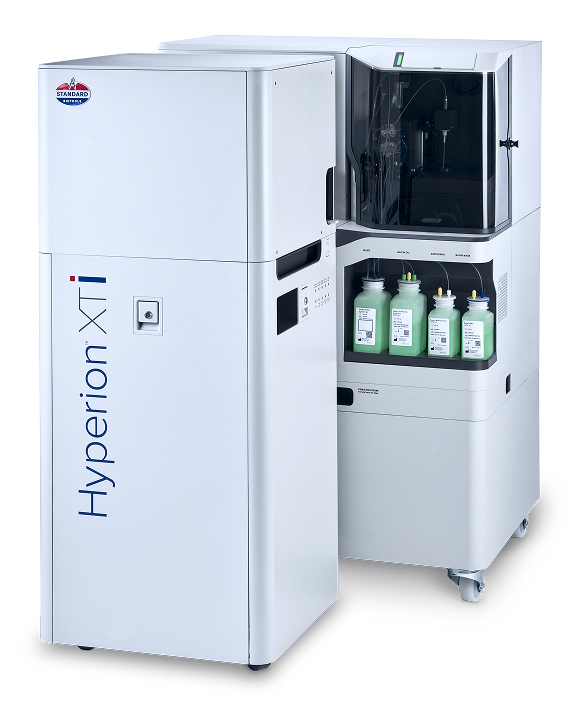Our Capabilities
Lorem ipsum dolor sit amet consectetur adipisicing elit sed
Technology Highlights
Lorem ipsum dolor sit amet consectetur adipisicing elit sed
Lorem ipsum dolor sit amet consectetur adipisicing elit sed
Lorem ipsum dolor sit amet consectetur adipisicing elit sed
Overview
The dynamics of tissue microenvironments play a crucial role in understanding disease progression, therapeutic response, and biomarker discovery. Imaging Mass Cytometry™ (IMC™) technology, powered by the Hyperion™ XTi Imaging System, enables researchers to explore the complexity of these dynamics with unparalleled precision. By detecting over 40 protein and RNA markers simultaneously in tissue samples, IMC uncovers spatial relationships that conventional imaging methods overlook.
Capabilities
Unlike traditional fluorescence-based imaging techniques, which often struggle with signal saturation and autofluorescence, IMC captures both high and low levels of protein expression in the same sample with exceptional clarity.
Because IMC technology uses an antibody reagent cocktail, it is simple to mix and match different antibodies without extensive assay validation.
Identify therapeutic targets that may be relevant to developing treatment strat…
With the Hyperion XTi™ Slide Loader, researchers can image up to 40 slides in 24 hours, making it easier to process large-scale studies and accelerate results without compromising precision – run an entire study in an automated, walkaway run.
IMC utilizes metal-tagged antibodies instead of fluorophores, eliminating issues with autofluorescence and delivering cleaner, more reliable data, even from challenging tissue samples.
Fluorescence-Based Imaging
Traditional imaging methods, such as cyclic immunofluorescence, are limited by their low dynamic range, autofluorescence interference, and slow, multi-cycle processes. For example, brightfield imaging (DAB) gives at best one order of magnitude (OoM) of dynamic range, while fluorescence gives 2–3 OoM and IMC gives 5 OoM.
Our Solution
Fluorescence-Based Imaging
IMC overcomes these challenges by capturing the full dynamic range of spatial biomarkers, detecting both high- and low-expressing proteins simultaneously. This approach eliminates the need for multiple imaging cycles and delivers high-resolution, quantitative data without the drawbacks of autofluorescence. IMC provides up to 100 times higher throughput than cyclic fluorescence, making it the ideal solution for large-scale research studies.
Staining Redundancy
< 20 Markers
Spectral Overlap
Fluorescence-Based Imaging
Traditional imaging methods, such as cyclic immunofluorescence, are limited by their low dynamic range, autofluorescence interference, and slow, multi-cycle processes. For example, brightfield imaging (DAB) gives at best one order of magnitude (OoM) of dynamic range, while fluorescence gives 2–3 OoM and IMC gives 5 OoM.
Our Solution
Fluorescence-Based Imaging
IMC overcomes these challenges by capturing the full dynamic range of spatial biomarkers, detecting both high- and low-expressing proteins simultaneously. This approach eliminates the need for multiple imaging cycles and delivers high-resolution, quantitative data without the drawbacks of autofluorescence. IMC provides up to 100 times higher throughput than cyclic fluorescence, making it the ideal solution for large-scale research studies.
Staining Redundancy
< 20 Markers
Spectral Overlap
Technology
CyTOF XT detects over 50 markers at once, far exceeding the limits of traditional flow cytometry. This enables a comprehensive analysis of immune populations and functional responses in a single experiment.
with no autofluorescence interference
with no autofluorescence interference

with no autofluorescence interference
with no autofluorescence interference
with no autofluorescence interference
with no autofluorescence interference
with no autofluorescence interference
with no autofluorescence interference
Lorem ipsum dolor sit amet consectetur
Use your Hyperion XTi Imaging System to perform high-multiplex analysis of b…
Discover the impact of new immune therapies including checkpoint inhibit…
Use your Hyperion XTi Imaging System to perform high-multiplex analysis of b…
Discover the impact of new immune therapies including checkpoint inhibit…
Use your Hyperion XTi Imaging System to perform high-multiplex analysis of b…
Discover the impact of new immune therapies including checkpoint inhibit…
Lorem ipsum dolor sit amet consectetur
HER2 Trial, Clin. Cancer Res. 2019
IMC was used in a Phase 3 clinical trial of trastuzumab to stratify patients by HER2 expression levels, revealing how the dynamic range of HER2 expression and proximity to CD8+ T cells predicted patient response. Reference: Carvajal-Hausdorf, D.E. et al. 2019, Clinical Cancer Research.
HER2 Trial, Clin. Cancer Res. 2019
IMC was used in a Phase 3 clinical trial of trastuzumab to stratify patients by HER2 expression levels, revealing how the dynamic range of HER2 expression and proximity to CD8+ T cells predicted patient response. Reference: Carvajal-Hausdorf, D.E. et al. 2019, Clinical Cancer Research.
HER2 Trial, Clin. Cancer Res. 2019
Breast CancerIMC was used in a Phase 3 clinical trial of trastuzumab to stratify patients by HER2 expression levels, revealing how the dynamic range of HER2 expression and proximity to CD8+ T cells predicted patient response. Reference: Carvajal-Hausdorf, D.E. et al. 2019, Clinical Cancer Research.
Jana Fischer, PhD
Co-Founder and CEO, Navignostics
Identify therapeutic targets that may be relevant to developing treatment strat…
Identify therapeutic targets that may be relevant to developing treatment strat…
Lorem ipsum dolor sit amet consectetur
Identify therapeutic targets that may be relevant to developing treatment strat…
Identify therapeutic targets that may be relevant to developing treatment strat…
Explore
Flyers and brochures
Hyperion XTi Imaging System Brochure | FLDM-01130
Hyperion XTi Imaging System Brochure | FLDM-01130
Spotlight articles
Download
Download
Download
Spotlight articles

Download

Download

Download
Lorem ipsum dolor sit amet consectetur
Identify therapeutic targets that may be relevant to developing treatment strat…
Lorem ipsum dolor sit amet consectetur
Identify therapeutic targets that may be relevant to developing treatment strat…